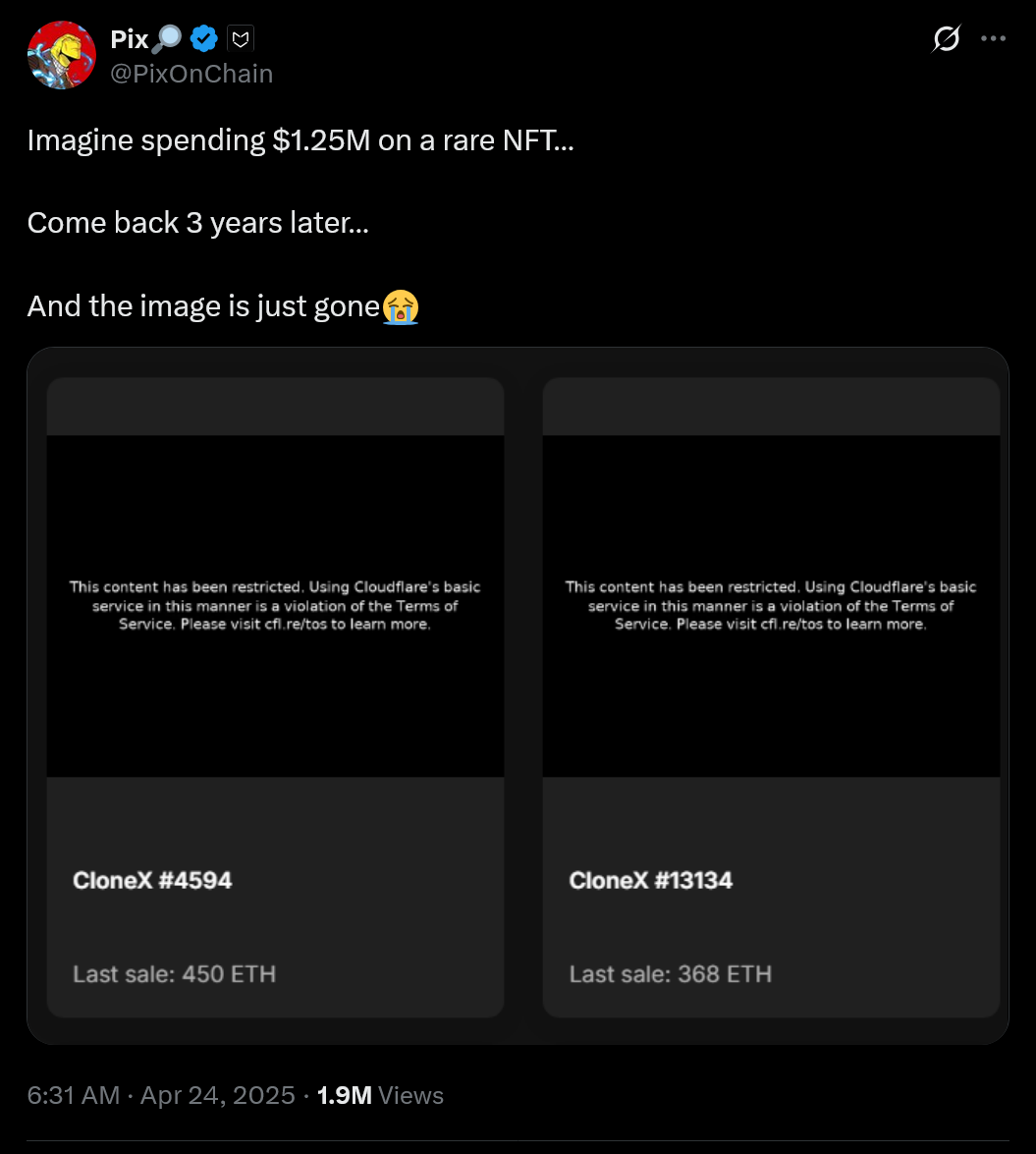More than 19,000 NFT images briefly disappeared last week thanks to a server problem

Remember NFTs? Essentially JPEGs that cost a lot of money, non-fungible tokens were really big for a brief while among C-tier celebrities, budding criminals, and Ubisoft, until the internet was finally able to bully them out of sight and thus out of mind: Not really gone, but mostly forgotten. But a funny thing recently happened that dragged them back into my memory: Thousands of NFTs that people had paid millions of dollars for very suddenly disappeared—or at least the images associated with them did—not the result of a rug pull but because nobody was paying for the servers.
According to a 404 Media report, this all goes back to 2021 when Nike, the shoe company, acquired RTFKT—pronounced “artifact,” although you can say it differently if you like—for an unknown but presumably astronomical amount of money. That partnership resulted in “CryptoKicks,” more prosaically described as pictures of sneakers that rich people paid obscene amounts of money for, but RTFKT also partnered with other creators to churn out similarly pricey digital images.
One of those collections was Clone X, made in collaboration with Japanese artist Takashi Murakami, and this how the RTFKT website describes it:
In a moment that would redefine the intersection of contemporary art and digital culture, legendary artist Takashi Murakami joined forces with RTFKT to create something unprecedented: a collection of 20,000 extraterrestrial avatar clones that would bridge the worlds of fine art, digital identity, and creative expression. This collaboration didn’t just merge NFTs with contemporary art—it catalyzed a new era of digital creativity that would generate over $1 billion in the secondary market and forever alter the landscape of digital identity.
Wow, eh? Ah, but it didn’t last. Nike soured on NFTs and announced at the end of 2024 that it was pulling the plug on RTFKT. Around the same time, RTFKT said it would launch a new website to “honor and preserve” its legacy, and “that showcases the groundbreaking work that defined the RTFKT journey.” And so it has.
But on April 24, more than 19,000 NFT images went poof for a few hours. It was awkward.

So what happened? According to the report, former RTFKT chief technology officer Samuel Cardillo, who stayed on as a consultant after Nike deep-sixed the operation, was moving the NFTs from a DigitalOcean cloud server to AWS, using Cloudflare as an intermediate part of the process. Carillo told 404 Media that he’d arranged to switch to a free Cloudflare plan because being on a paid plan “makes absolutely no sense anymore,” what with RTFKT no longer existing, but Cloudflare triggered the change too soon. Whoops.
The NFTs were only gone for a few hours so no real harm done, aside from a bit of panic among any NFT owners who noticed their pictures had turned into error messages. But I think it’s a very interesting reflection on the nature of NFTs, their impermanence, and their reliance on technology to “exist” at all. Cardillo said on April 28 that the Clone X collection had successfully migrated to Arweave, a decentralized storage system that will ensure this sort of thing cannot ever happen again.
Maybe that’s true and maybe it’s not—there’s a distinct ring of “unsinkable” to that sort of language, which rarely ends well—but as DL News explained, it’s something of an ongoing issue with NFTs and those who believe they have value. While the non-fungible tokens exist on blockchains, associated images are often stored on conventional servers, and if something happens to those servers—as was the case with Cloudflare—they, rather like the infamous apes of legend, are gone.
The site also noted that while some Clone X NFTs sold for more than $1 million at their peak, they now list for about 300 bucks each. That’s not a server problem, though, that’s just how it goes.




